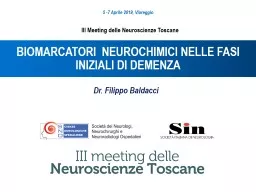PPT-BIOMARCATORI NEUROCHIMICI
Author : briana-ranney | Published Date : 2020-04-03
NELLE FASI INIZIALI DI DEMENZA Dr Filippo Baldacci 5 7 Aprile 2019 Viareggio III Meeting delle Neuroscienze Toscane Abbreviations A β42 amyloid β42 ALS amyotrophic
Presentation Embed Code
Download Presentation
Download Presentation The PPT/PDF document " BIOMARCATORI NEUROCHIMICI " is the property of its rightful owner. Permission is granted to download and print the materials on this website for personal, non-commercial use only, and to display it on your personal computer provided you do not modify the materials and that you retain all copyright notices contained in the materials. By downloading content from our website, you accept the terms of this agreement.
BIOMARCATORI NEUROCHIMICI : Transcript
Download Rules Of Document
" BIOMARCATORI NEUROCHIMICI "The content belongs to its owner. You may download and print it for personal use, without modification, and keep all copyright notices. By downloading, you agree to these terms.
Related Documents

